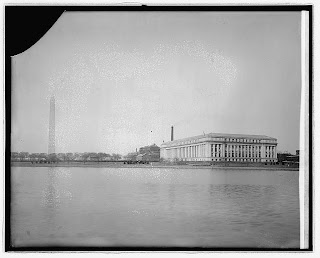In the late 1840s, the Washington National Monument Society, a private civic-minded organization, was raising funds to build the nation’s first monument to George Washington.
The group was successful and by 1862, the base of the Washington Monument had been completed by mostly Irish laborers with imported Italian Marble, much to the annoyance of local Maryland quarry owners who felt that the Monument should have been constructed in Maryland marble. (The monument is made of not only marble but also granite, and sandstone)
The Architect was Robert Mills who also designed the Department of Treasury building and several other federal buildings in D. C. including the U.S. Patent Office Building. Mills died in 1855 and was buried at the Congressional Cemetery.
It so happened that at certain sections of the Monuments interior inscripted stones from various heads of state were to dot the walls, including one stone sent by the Pope, Pius IX. Pius had gone to Rome as a very young man to become a pontifical guard, however, epilepsy kept him out of the legendary Swiss Guard. It was Pius who convened the First Vatican Council in 1869, which decreed papal infallibility in church matters. He also defined the dogma of the Immaculate Conception of the Blessed Virgin Mary, meaning that Mary was conceived without original sin and that she lived a life completely free of sin.
The Pope had been invited by the US government to contribute the memorial stone. He sent a black marble block measuring approximately three feet long, 18 inches high, and 10 inches deep, that had been taken from the ruins of the ancient Temple of Concord the western side of the Roman Forum., and had it inscribed “Rome to America”. The stone arrived in DC in October of 1853.
At that time, anti-Catholic-anti Irish sentiment in the US was enormous and soon a rumor spread, not only across the city, but across the country, that the monument was not to be in honor of the Americas first President, but instead, it was to be dedicated to Pope in Rome, as a symbol to the nation’s growing Irish- Catholic population. There was even a bestselling pamphlet by John F. Weishampel entitled Rome to America: the Pope’s Stratagem! An address to the Protestants of the United States against placing the Pope’s block of marble in the Washington Monument.
On the night March 5, 1854, members of the Know Nothing party (Reports ranged from five or six thugs to as many as 750) attacked the work site, overpowered it guards and set about destroying monument as best they could. (At the time it stood only 153 feet in the air) The so-called Pope’s stone, together with monumental blocks from other countries, was stored in a shed. Upon finding the offending stone, they flung it into the nearby Potomac River. (The rover had not yet been redirected and was only several yards away from the monument) That Stone has never been found.
Appalled at the attack, the Washington National Monument Society appealed to Congress for assistance in completing the monument and Maryland Representative Henry May (May was born in DC and graduated from the Columbian College, which is now GW University) had all but arranged a federal appropriation of $200,000.
The following year, in 1863, the Know Nothings took control of the committee set up to complete the Washington Monument. Under Know Nothing Control, work on the monument came to a virtual standstill. At the end of the civil war, the monument was completed, this time with Maryland Marble. The difference in the stones can be seen today about midway up the Statue.
The capstone was set on December 6, 1884, and the completed monument was dedicated on February 21, 1885. (A day before Washington’s Birthday) It officially opened October 9, 1888.
Upon completion, it became the world's tallest structure, a title previously held by the Cologne Cathedral. The monument held this designation until 1889, when the Eiffel Tower was completed in Paris, France. It remains the world's tallest stone structure, the world's tallest obelisk and the tallest building in Washington, D.C (There is a popular misconception that the law specifically states that no building may be taller than the Washington Monument, but in fact, the law makes no mention of it)
Among those who spoke before the crowd of 800 was Ohio Senator John Sherman, (Brother of William Tecumseh Sherman who led the military procession that day, it was John Sherman who wrote the Sherman anti-trust act) William Wilson Corcoran of DC, (Of the Corcoran gallery of Art fame) Thomas Lincoln Casey of the Army Corps of Engineers. Casey headed the Office of Public Buildings and Grounds for the then federally run District of Columbia. He built the State, War, and Navy Department Building (now the Eisenhower Executive Office Building) and completed the Washington Monument. He also worked on the Library of Congress building, which was nearly completed when he died suddenly on March 25, 1896.
President Chester Arthur was also present and Representative John Davis Long read a speech given 37 years before at the laying of the monuments cornerstone. The final speech given Virginia Governor John Warwick Daniel, a lawyer, author, and politician from Lynchburg. A major in the Confederate Army, Daniel was an important staff officer for Major General Jubal A. Early in several campaigns, including Gettysburg. He was permanently disabled in the Battle of the Wilderness in May 1864
Despite being unable to walk as a result of his war wounds, Daniel’s enter law school and was admitted to the bar in 1866. He established his practice at Lynchburg and then entered politics. It was Daniel who planned the Virginia Memorial on the Gettysburg Battlefield.





